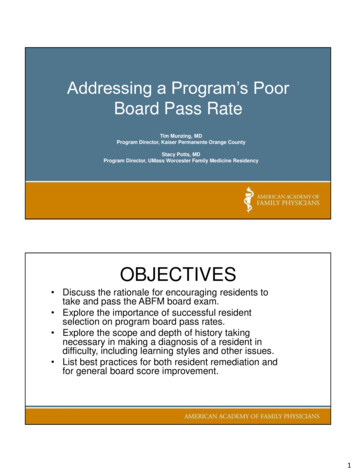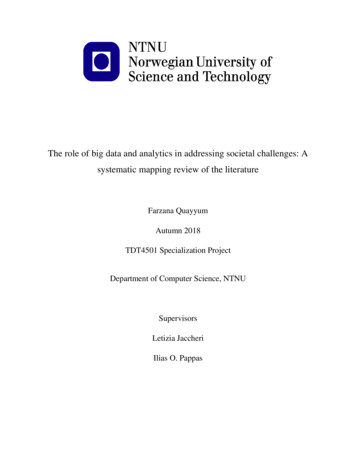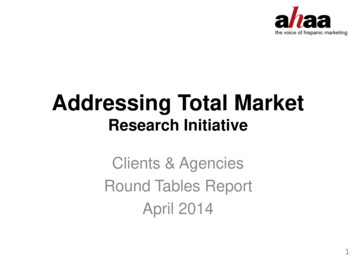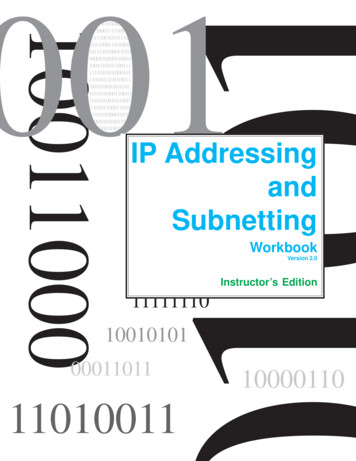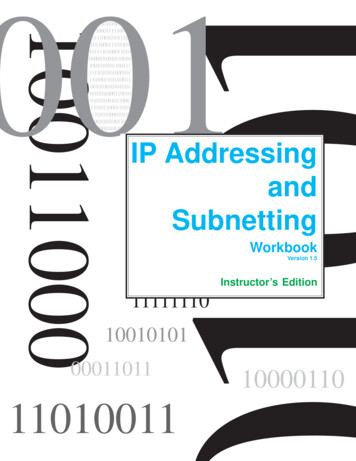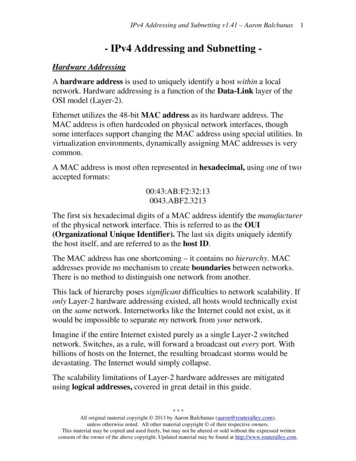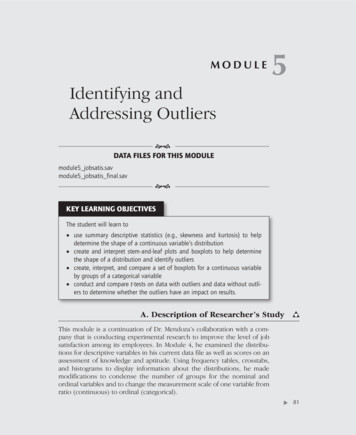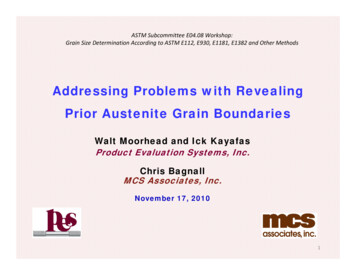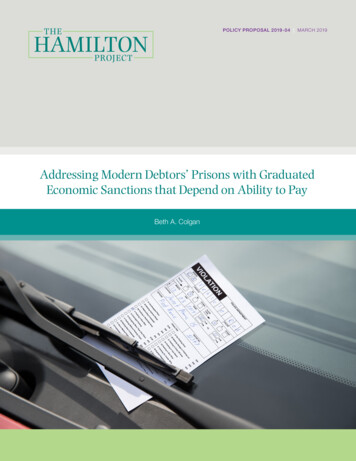
Transcription
POLICY PROPOSAL 2019-04 MARCH 2019Addressing Modern Debtors’ Prisons with GraduatedEconomic Sanctions that Depend on Ability to PayBeth A. Colgan
MISSION STATEMENTThe Hamilton Project seeks to advance America’s promiseof opportunity, prosperity, and growth.We believe that today’s increasingly competitive global economydemands public policy ideas commensurate with the challengesof the 21st Century. The Project’s economic strategy reflects ajudgment that long-term prosperity is best achieved by fosteringeconomic growth and broad participation in that growth, byenhancing individual economic security, and by embracing a rolefor effective government in making needed public investments.Our strategy calls for combining public investment, a secure socialsafety net, and fiscal discipline. In that framework, the Projectputs forward innovative proposals from leading economic thinkers— based on credible evidence and experience, not ideology ordoctrine — to introduce new and effective policy options into thenational debate.The Project is named after Alexander Hamilton, the nation’sfirst Treasury Secretary, who laid the foundation for the modernAmerican economy. Hamilton stood for sound fiscal policy,believed that broad-based opportunity for advancement woulddrive American economic growth, and recognized that “prudentaids and encouragements on the part of government” arenecessary to enhance and guide market forces. The guidingprinciples of the Project remain consistent with these views.
Addressing Modern Debtors’ Prisons withGraduated Economic Sanctions that Depend onAbility to PayBeth A. ColganUCLA School of LawMARCH 2019This policy proposal is a proposal from the author(s). As emphasized in The Hamilton Project’soriginal strategy paper, the Project was designed in part to provide a forum for leading thinkersacross the nation to put forward innovative and potentially important economic policy ideasthat share the Project’s broad goals of promoting economic growth, broad-based participationin growth, and economic security. The author(s) are invited to express their own ideas in policypapers, whether or not the Project’s staff or advisory council agrees with the specific proposals.This policy paper is offered in that spirit.The Hamilton Project Brookings1
AbstractThere is growing evidence that the use of economic sanctions—fines, fees, surcharges, and restitution—at amounts that peoplehave no meaningful ability to pay, results in significant financial and social instability for debtors and their families, andincreased crime rates. These sanctions also have a delegitimizing effect on criminal justice systems that people see as moreinterested in revenue generation than fairness. This paper proposes policy solutions centered on the creation of a systemof graduating economic sanctions according to a person’s ability to pay, and designed to meet the criminal justice goals ofsentencing equality and crime reduction, while also improving outcomes for people and their families who would otherwisecarry unmanageable criminal debt.2Addressing Modern Debtors’ Prisons with Graduated Economic Sanctions that Depend on Ability to Pay
Table of ContentsABSTRACT2INTRODUCTION4THE CHALLENGE6THE PROPOSAL13QUESTIONS AND CONCERNS23CONCLUSION28AUTHOR AND ACKNOWLEDGMENTS29ENDNOTES30REFERENCES31The Hamilton Project Brookings3
IntroductionThe use of economic sanctions to punish crimes rangingfrom minor traffic or public order offenses to the mostserious felonies is ubiquitous in the United States.Nationally, millions of people hold billions of dollars ofcriminal debt from past economic sanctions imposed at thestate and local level (Martin, Smith, and Still 2017). Federally,as of fiscal year 2017 approximately 300,000 people owed nearly 136 billion in criminal debt, nearly 90 percent of which thefederal government categorizes as uncollectable because of thelimited financial resources of the debtors (Federal SentencingGuidelines Commission 2016; U.S. Department of Justice 2018;U.S. Government Accountability Office 2018).For many, payment of criminal justice debt stemming fromeconomic sanctions is infeasible, particularly for those whoalready struggle to meet basic needs or who have limitedability to save, as well as those who face difficulties obtainingstable employment due to a record of conviction, chemicaldependency, developmental or physical disability, or mentalillness.that certain conduct is designated as illegal because it allowsthe government to engage in revenue generation or socialcontrol, rather than to provide public safety.1 Nor does thispaper address problems related to inconsistent applicationof economic sanctions. Studies suggest, for example, thatboth the imposition and amount of economic sanctions maydepend on whether a person lives in a rural or urban area,the nature of the offense (divorced from offense seriousness),and the individual characteristics of the person sentencedincluding race, education level, and perceived financialcondition (Cole et al. 1987; Harris, Evans, and Beckett 2011;Olson and Ramker 2001; Pleggenkuhle 2018; Ruback andBergstrom 2006; Ruback and Clark 2011). Each of thoseconcerns is worthy of further study and consideration. Thispaper, however, assumes that economic sanctions will be usedas a form of punishment for at least some offenses, and seeksto provide a mechanism to make those sanctions a fairer andmore equitable—albeit imperfect—method of punishment.The inability to pay criminal justice debt quickly and in fullcan result in long-term, disastrous consequences. In manyjurisdictions, outstanding criminal debt accrues additionalfinancial penalties, including interest, late fees, and otherassorted collections costs that at times outpace the amountinitially imposed. This can make it impossible for peopleof limited means to ever pay the principal, keeping peopleembroiled in perpetual debt and punishment even forminor offenses. And for those who miss a payment or giveup in the face of insurmountable debt, nonpayment maylead to constitutionally questionable practices, such as thedeprivation of driver’s and occupational licenses, publicbenefits, and voting rights; the extension of probation orparole; or even incarceration. As a result, some describethe imposition of unmanageable economic sanctions andadditional penalties for nonpayment as a form of moderndebtors’ prison (American Civil Liberties Union [ACLU]2010).To that end, this paper offers a series of proposals related to thecreation of mechanisms for economic sanctions that graduateaccording to a person’s ability to pay. The first proposal focusesexclusively on structuring objective criteria for assessing aperson’s financial condition and his or her ability to makepayments on criminal debt. The second proposal offers threemethods of applying the determination of financial conditionto assessment of sanctions: (1) a flat reduction of a percentageof the economic sanctions that would otherwise be imposedfor those below a particular financial threshold; (2) a slidingscale approach that allows for greater granularity in sanctions;and (3) a day-fines model in which the person’s adjusted dailyincome is multiplied by a penalty unit established througha ranking of offense seriousness to calculate the amount ofeconomic sanctions to impose. This paper also recommendsthe application of graduation to all forms of economicsanction—including surcharges, fees, collection costs, andrestitution—to ensure that the full amount of the sanctionsimposed is within a person’s ability to pay, along with theadoption of a distribution scheme that prioritizes restitution.As attention to the consequences of using economicsanctions as punishment has increased, important legal andeconomic questions have arisen about their continued use.This paper, however, does not address growing concernsIn addition, this paper offers a series of related proposalsintended to support the goals of graduation, includingprocedures for postsentence modification when unexpectedchanges in financial circumstances occur, a requirement that4Addressing Modern Debtors’ Prisons with Graduated Economic Sanctions that Depend on Ability to Pay
collections periods be time-limited, the use of supportivecollections practices, the adoption of amnesty programs forthose with debt predating the implementation of reforms,limitations on collateral consequences and the eliminationof penalties for nonpayment that make it more difficultfor people to pay, and the development of noncarceral,noneconomic punishment alternatives.The Hamilton Project Brookings5
The ChallengeAcross the United States, many different economicsanctions are used in municipal, traffic, juvenile,misdemeanor, and felony courts (Feierman et al. 2016;Harris 2016; White House 2015). There are several standardcategories of economic sanction in use (Colgan 2014, 2018;Katzenstein and Waller 2015; Martin et al. 2018; Ruback2015). First are statutory fines, that can range from one dollarto millions of dollars, depending on the seriousness of theoffense. Second are surcharges, the amount of which is eithera percentage of the statutory fines imposed or a flat amountadded on top. Surcharges often are designated for specificpurposes, including a wide array of public services unrelatedto the charged offense or the court system. Third is restitution,which is payable to the victim for the purpose of making thevictim whole. Finally, there are administrative fees; theseare at least nominally intended to recoup system expenses,and include, among other things, fees imposed for the use ofindigent defense counsel or a jury, for prosecution and lawenforcement investigation costs, for pretrial and postconvictionincarceration costs, for probation or parole supervision, andmore. The wide reach of these sanctions is illustrated by figure1, which shows that 60 percent of people incarcerated in statefacilities and 92 percent of people incarcerated in federalfacilities have experienced some form of monetary sanction.Economic sanction amounts can vary widely fromjurisdiction to jurisdiction. Supervision fees, for example,range from a low of around 15 to more than 100 per month,a difference that accrues as each month of supervision passes(Ruhland et al. 2017). An even wider gulf can exist withrespect to indigent defense fees. While some jurisdictionsimpose a flat fee of a few hundred dollars, other jurisdictionscharge the full cost of representation—at times in the tens ofthousands of dollars—even though the person qualified fordefense representation due to indigency.These various forms of economic sanction add up, oftenturning what would otherwise have been a low statutory fineinto a much more substantial total penalty. For example,a 2012 analysis of traffic tickets in California conducted forthe California Assembly’s Committee on Appropriationsdescribed how a statutory fine of 100 rose to 490 (see tableFIGURE 1.Percent of people incarceratedPercent of People Incarcerated with a Court-Imposed Monetary Sanction, by Type ofSanction and Level of Government100Federal8060State40200Any monetary sanctionCourt costsFinesSource: Liu, Nunn, and Shambaugh (2019) based on data from the Survey of Inmates in State and Federal Correctional Facilities, BLS (2004).Note: Data are restricted to inmates sentenced to serve time. See Harris, Evans, and Beckett (2010) for additional information.6Addressing Modern Debtors’ Prisons with Graduated Economic Sanctions that Depend on Ability to PayRestitution
1), and a statutory fine of 500 jumped to 1,829, in both casesas a result of numerous surcharges and fees. Table 1 showsthat those additional economic sanctions ranged from a 1assessment to fund night court to a 100 flat surcharge (Long2012; Lawyers Committee for Civil Rights et al. 2015).ABILITY TO PAYWhile some people have the financial capacity to payeconomic sanctions when they are assessed, or within a shorttime thereafter, many simply are not able to pay sanctions.The 2017 Supplemental Poverty Measure—which measurespoverty rates by assessing income including the effects oftaxes and noncash benefits, as well as estimating expendituresfor basic necessities, medical, and work-related expenses—revealed that 13.9 percent of people in the United States areliving in poverty (Fox 2018). Many people on public benefitsare unable “to secure even the basic necessities . . . , and areforced to sacrifice one need for another, e.g., not eat in orderto pay for heat,” leaving little flexibility for the payment ofeconomic sanctions (City of Richland v. Wakefield 2016). Evenpeople with paid employment living above the federal povertyline may be likely to experience significant difficulty payingoff criminal debt (Pogrebin et al. 2014). For example, in manystates people earning minimum wage take home a monthlyincome between approximately 1,700 (where the minimumwage is 7.25 per hour) and 2,050 (where the minimum wageis 10.10 per hour) after accounting for the Earned IncomeTax Credit (EITC). In either case, those income levels are justover the federal poverty level for a single parent householdwith two children (Garver 2014). While still better off thanthose living below the federal poverty level, those familiesmust pay housing, food, hygiene, medical expenses, child-carecosts, and more before they can save, making it unlikely thatthey will have meaningful liquidity or savings on which theycan draw (Beverly and Sherraden 1999). People living withlimited economic slack, therefore, must cut back on essentialitems when placed under financial pressure (Mullainathanand Shafir 2010).This problem is exacerbated by a lack of access to financialinstitutions. Approximately 9 million U.S. householdsare unbanked, meaning that no person in the householdTABLE 1.Cost of an Infraction Citation in California Traffic CourtAssessmentBase Fine (Example)AmountOwed 100State Penalty Assessment (Penal Code (PC) §1464) 10 for every 10 base fine 100State Criminal Surcharge (PC §1465.7)20% surcharge on base fine 20 40 fee per fine 40Court Construction (Government Code (GC) §70372) 5 for every 10 in base fine 50County Fund (GC §76000) 7 for every 10 in base fine 70DNA Fund (GC §76104.6 and §76104.7) 5 for every 10 in base fine 50Emergency Medical Air Transportation Fee (GC §76000.010) 4 for every 10 in base fine 4EMS Fund (GC §76000.5) 2 for every 10 in base fine 20Conviction Assessment (GC §70373) 35 fee per fine 35Night Court Assessment (GC §42006) 1 fee per fine 1Court Operations Assessment (PC §1465.8)Actual Cost of Citation 490DMV Warrant/Hold Assessment Fee (Vehicle Code (VC) §40508.6) 10 feeFee for Failing to Appear (VC §40508.5) 15 feeCivil Assessment for Failure to Appear/Pay (PC §1214.1)Cost of Citation if Initial Deadline is Missed 300 fee 815Source: Lawyers Committee for Civil Rights et al. 2015.Note: These data are for 2015.The Hamilton Project Brookings7
has a bank account from which savings could be drawn(Federal Deposit Insurance Corporation [FDIC] 2015).Unbanked households are particularly prominent inminority neighborhoods, where there are fewer, if any, banks(Baradaran 2014; Beverly and Sherraden 1999). People whoare unbanked must turn to significantly more-expensivelending options such as payday loans to pay criminal debt(Alabama Appleseed 2018).In light of these limitations on income and savings, it isunsurprising that the Federal Reserve’s 2017 Survey ofHousehold Economics and Decisionmaking showed that,while overall economic well-being had improved in theprevious five years, more than one quarter of adults in theUnited States are not capable of paying all of their monthlybills in full, more than one quarter of adults skippednecessary medical care due to a lack of funds, and four outof ten adults said that they would have difficulty covering anunexpected 400 expense without selling personal effects orborrowing money (Board of Governors of the Federal ReserveSystem 2018). As figure 2 illustrates, the median fine acrossmajor counties is often high, indicating that many individualswould find it difficult to pay these economic sanctions.The ability to pay economic sanctions is likely even fartherout of reach for people who are sentenced to terms ofincarceration. Of people charged with misdemeanor orfelony offenses for which incarceration is a possible sentence,between 80 and 90 percent qualify for indigent defenserepresentation due to an inability to pay for counsel (Bannon,Nagrecha, and Diller 2010; Patel and Phillip 2012). Thosefigures reflect the limited incomes many people have prior toarrest (Rabuy and Kopf 2015). Furthermore, those who aresentenced to terms of incarceration may have no ability toearn an income while incarcerated—employment within jailsand prisons can be sparse, and wages can range from a fewcents to a few dollars per hour (Evans 2014; Katzenstein andWaller 2015; Link 2017).After release from incarceration, many people struggle tomeet even their basic human needs, including food, shelter,and hygiene (Harding 2014). A criminal conviction cansignificantly narrow employment prospects. In some cases,this is due to statutory limitations on occupational licensesor other disqualifications triggered by certain convictions(National Reentry Resource Center 2018). In others, it is dueto private employer reluctance to hire, a reluctance that canbe exacerbated by perceived administrative burdens relatedto wage garnishment when it is used as a mechanism forcollecting criminal debt (Agan and Starr 2017; Beckett andHarris 2011; Evans 2014; Pager 2003; Petersilia 2000; Western2006). Employment opportunities may also be reduced forpeople with mental health or chemical dependency issues,or who have physical disabilities, all of which occur atsignificantly higher rates among both adults and juvenileswho are incarcerated than in the general population (Bronson,Maruschakand, and Berzofsky 2015; Bronson et al. 2017; JamesFIGURE 2.Median Fine and Restitution Amounts for Selected Counties, 1990–20092016 Source: Martin et al. (2018).Note: Data are from the State Court Processing Statistics (SCPS). The median restitution for Bronx, NY, is unobservable because no casesincluded in the SCPS reported a restitution sentence. Fines and restitution are expressed in 2016 dollars.8Addressing Modern Debtors’ Prisons with Graduated Economic Sanctions that Depend on Ability to Pay
and Glaze 2006; Subramanian et al. 2015; Underwood andWashington 2016). Limitations on employment opportunitieshit people of color particularly hard, because they are morelikely to be subject to employment discrimination due toperceptions of criminality (Agan and Starr 2017) and toreturn to communities with few employment options (Bell2018; Pleggenkuhle 2018). For those lucky enough to findemployment it is more likely to be only minimum-wage orpart-time work without benefits, leaving them with limitedability to pay anything beyond what is necessary to meetbasic needs (Pogrebin et al. 2014; Ruhland et al. 2017). Inshort, people returning from periods of incarceration are lesslikely to be employed, more likely to earn lower wages whenthey do obtain employment, and thus are more likely to havesignificant financial instability that will hamper paying offcriminal debt (Western and Pettit 2010a).Whether incarcerated or not, for those unable to payeconomic sanctions immediately, additional financialpenalties can accrue. Many jurisdictions charge interest andmonthly collections costs, often at rates that make it difficultfor a person of limited means to pay the principal debt(Colgan 2018). Jurisdictions also often impose significant feesfor late or missed payments—nearly doubling the economicsanctions imposed for the California traffic ticket describedabove, for example—that again can push paying off criminaldebt in full farther out of reach (Lawyers Committee forCivil Rig
This paper proposes policy solutions centered on the creation of a system . 136 billion in criminal debt, nearly 90 percent of which the . (

